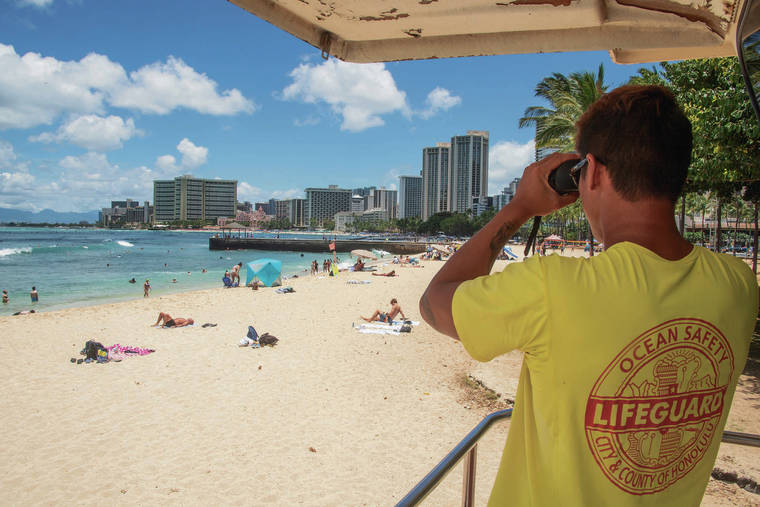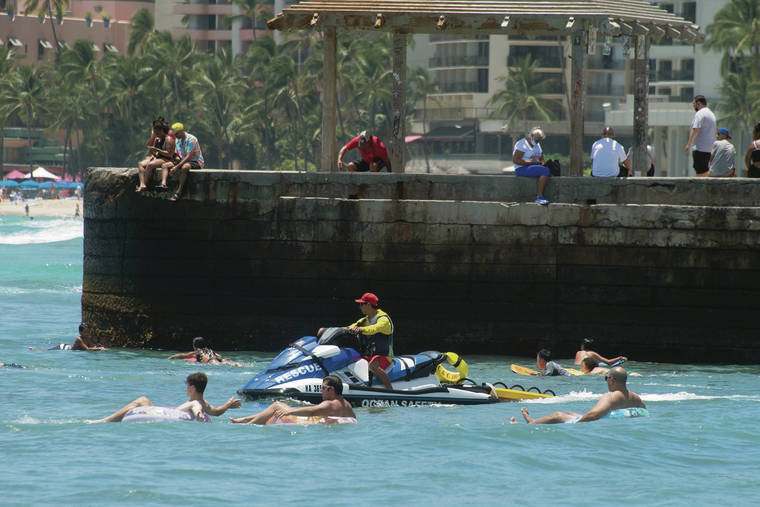Antic bodyboarders rode the fun-size waves of a diminishing summer swell at Walls by Waikiki’s Kapahulu Groin on Friday, while onshore, at Lifeguard Tower 2-E, officials with the Honolulu Emergency Services Department announced in a news conference that, starting Sunday, Ocean Safety personnel in mobile units would be on duty from
7 a.m. to 7 p.m., extending their current work hours of 9 a.m. to 5:30 p.m.
“What jumps out, looking at our data over the past three years, is between the hours of 5 to 7 p.m., and also the early morning hours, no doubt we are necessary. The number of calls is more than any other time,” Ocean Safety Chief John Titchen said in an interview.
For the hours of 5 to
7 p.m., 141 ocean-related 911 emergency calls occurred in 2019. There were 172 calls in 2020, and there have been 130 calls thus far this year.
From Jan. 1 through Monday, 43 calls came in before lifeguards came on morning duty.
For now, due to budgetary constraints, the hours of lifeguards stationed in the division’s towers islandwide will remain unchanged.
Officials determined that extending the hours of mobile units — plus adding more mobile units — would be the most effective way to expand the presence of the division’s 250 personnel, who staff 41 towers around the island and a fleet of mobile response vehicles to cover Oahu’s 227 miles of coastline out to a mile from shore, Titchen said.
Ocean Safety currently dispatches eight rescue Jet Ski teams daily to patrol near-shore waters. Starting Sunday, it will double the number of its land-based mobile units to 16 from eight, for a total of 24 mobile response teams working throughout daylight hours.
The expansions represent the first phase of a program implemented under city Ordinance 19-26, passed in late 2019, which requires the director of the Honolulu Emergency Services Department to begin an all-daylight-hours lifeguarding program.
“There is no debate that this law will save lives,” said Jim Ireland,
director of Emergency Services, in the announcement.
As things have stood, “our lifeguards often stay late at the end of a work day that ends right now at 5:30 p.m., and they often are called to come in earlier than our current
9 a.m. start time,” Ireland said.
At Walls, just the day before, in larger surf at about 4:30 p.m., Ocean Safety lifeguards on personal watercraft rescued an unresponsive swimmer. The 47-year-old man was given CPR onshore and transported to an emergency room.
“At places like Walls, where it’s super shallow, a Jet Ski can negotiate in a few inches of water,” Titchen said. “The point we’re trying to make is, the best way to achieve expanded hours, and get there fast, is to expand our mobile service.”
As of Friday afternoon Ocean Safety had responded to eight drownings islandwide in the past 10 days, he said.
“Waikiki, Kahe Point, Ewa Beach, Waimea Bay — every beach is dangerous,” he said, adding that nowadays, particularly among tourists who’d been cooped up during the pandemic, “we’re seeing people aren’t as fit as they used to be.”
The added presence of tower lifeguards, who help prevent accidents by observing and warning beachgoers, is also critically needed, Titchen said, noting that due to limited financial resources, the plan to increase coverage to cover all daylight hours will be incremental and might take several years to fully achieve.
“We need more lifeguards,” he said, but the city is fiscally challenged right now.
The cost of extending personnel hours, he added, was roughly $1 million for the first phase.
“We promoted nine personnel to lieutenant, who are lead mobile responders. They move in trucks that carry equipment and personnel where they are needed,” he said.
“We want to remind the public that just because a tower is closed does not mean lifeguards are not on duty nearby; (they) can respond via truck or Jet Ski,” and so people should remember to call 911 for ocean-related emergencies.
He said he the next step would likely be to continue to increase Ocean Safety’s Jet Ski coverage.








